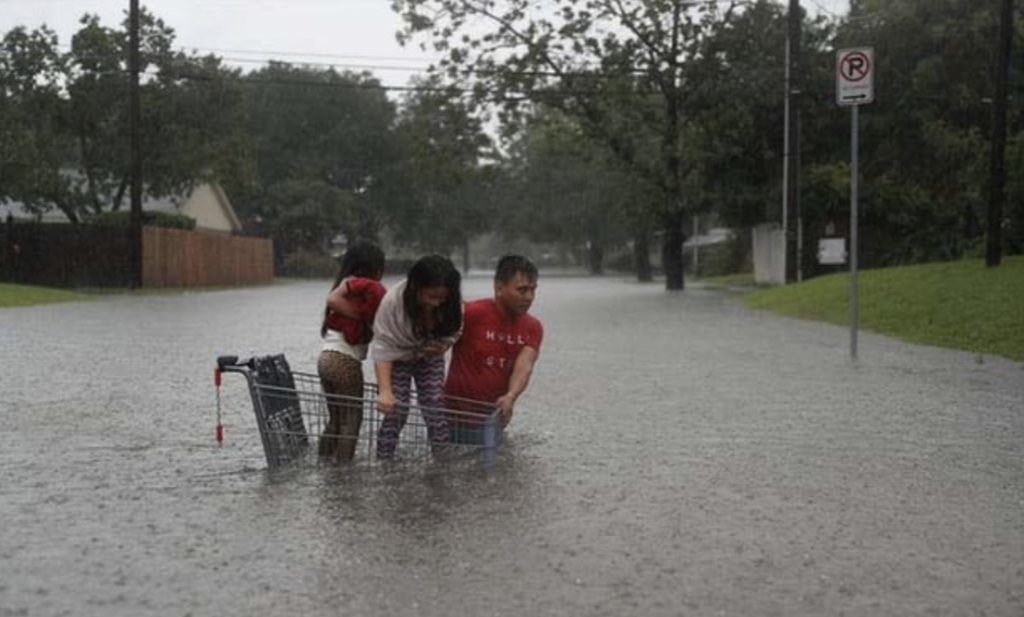2017

by Dr. Michael Mann
What can we say about the role of climate change in the unprecedented disaster that is unfolding in Houston with Hurricane Harvey? There are certain climate change-related factors that we can, with great confidence, say worsened the flooding.
Sea level rise attributable to climate change – some of which is due to coastal subsidence caused by human disturbance such as oil drilling – is more than half a foot (15cm) over the past few decades (see here for a decent discussion). That means the storm surge was half a foot higher than it would have been just decades ago, meaning far more flooding and destruction.
In addition sea surface temperatures in the region have risen about 0.5C (close to 1F) over the past decades from roughly 30C (86F) to 30.5C (87F), which contributed to the warm sea surface temperatures (30.5-31C, or 87-88F).
There is a simple thermodynamic relationship known as the Clausius-Clapeyron equation that tells us there is a roughly 6% increase in average atmospheric moisture content for each 1.0o C of warming. Sea surface temperatures in the area where Harvey intensified were 0.5-1C warmer than current-day average temperatures, which translates to 1-1.5C warmer than “average” temperatures a few decades ago. That means 3-5% more moisture in the atmosphere.
That amount of moisture creates the potential for much greater rainfalls and greater flooding. The combination of coastal flooding and heavy rainfall is responsible for the devastating flooding that Houston is experiencing.
Not only are the surface waters of the Gulf of Mexico unusually warm right now, but there is a deep layer of warm water that Harvey was able to feed upon when it intensified at near record pace as it neared the coast. Human-caused warming is penetrating down into the ocean. It’s creating deeper layers of warm water in the Gulf and elsewhere. Sea surface temperatures in the region have risen about 0.5oC (close to 1o F) over the past few decades
Harvey was certainly more intense than it would have been in the absence of human-caused warming, which means stronger winds, more wind damage and a larger storm surge. (As an example of how this works, we have shown that climate change has led to a dramatic increase in storm surge risk in New York City, making devastating events like Hurricane Sandy more likely).
Finally, the more tenuous but potentially relevant climate factors: part of what has made Harvey such a devastating storm is the way it has stalled near the coast. It continues to pummel Houston and surrounding regions with a seemingly endless deluge, which will likely top out at nearly 4ft (1.22m) of rainfall over a days-long period before it is done.
The stalling is due to weak prevailing winds, which are failing to steer the storm off to sea, allowing it to spin around and wobble back and forth. This pattern, in turn, is associated with a greatly expanded subtropical high pressure system over the US, with the jet stream pushed well to the north. This pattern of subtropical expansion is predicted in model simulations of human-caused climate change.
More tenuous, but possibly relevant still, is the fact that very persistent, nearly “stationary” summer weather patterns of this sort, where weather anomalies (both high-pressure dry hot regions and low-pressure stormy/rainy regions) stay locked in place for many days at a time, appears to be favoured by human-caused climate change. We recently published a paper in the academic journal Scientific Reports on this phenomenon.
In conclusion, we cannot say climate change “caused” Hurricane Harvey, we can say is that it exacerbated several characteristics of the storm in a way that greatly increased the risk of damage and loss of life. Climate change worsened the impact of Hurricane Harvey.
Michael E Mann is distinguished professor of atmospheric science at Pennsylvania State University, director of the Penn State Earth System Science Center and author of three books, including The Hockey Stick and The Climate Wars, Dire Predictions, and The Madhouse Effect.